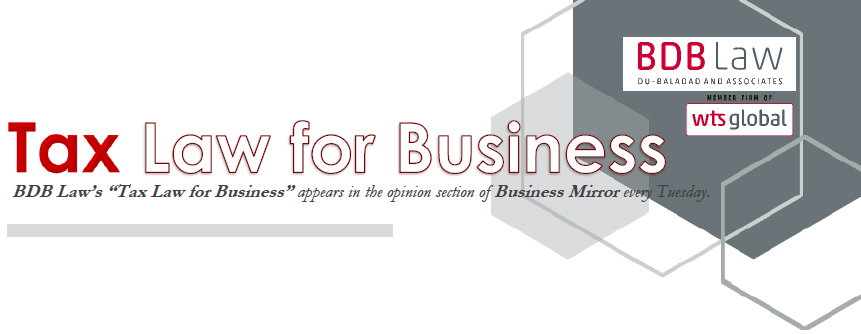With the proposal to harmonize the tax treatment across financial transactions, the rate would be the same regardless of who the investor is and regardless of the nature of the investment instruments.


One Final Withholding Tax Rate
By Atty. Fulvio D. Dawilan
"With the proposal to harmonize the tax treatment across financial transactions, the rate would be the same regardless of who the investor is and regardless of the nature of the investment instruments. Among others, this would eliminate the need to apply for tax treaty reliefs or the tax sparing provision, simply for the purpose of availing lower tax rates. More importantly, this would eliminate the necessity of requiring detailed information from the investors as the above-mentioned invalidated issuances sought to impose.”
For various reasons, the Supreme Court, in G.R. No. 213860, invalidated Revenue Regulations No. 1-2014, Revenue Memorandum Circular No. 5-14 and SEC Memorandum Circular No. 10-2014. Compared to the previous rules, these issuances required the submission of more information in the alphabetical list (alphalist). Among others, the issuances discontinued the practice of submitting alphalist where the income payments and the taxes withheld are lumped into one single amount, such as “Various Payees”, “PCD Nominees”, “Others”, etc. Instead, they required the reporting of more detailed information about the payees/investors and the income paid to them and the corresponding taxes withheld.
 Apparently, under our present tax system, there are numerous tax rates applicable even on similar transactions. And the tax rates become more complicated when applied to different situations. The tax on income, for example, depends on so many factors and conditions - including the nature of investment, the term of the instrument, the issuer, the currency involved, whether the investor is an individual or juridical person, residency of the investors and many other considerations.
Apparently, under our present tax system, there are numerous tax rates applicable even on similar transactions. And the tax rates become more complicated when applied to different situations. The tax on income, for example, depends on so many factors and conditions - including the nature of investment, the term of the instrument, the issuer, the currency involved, whether the investor is an individual or juridical person, residency of the investors and many other considerations.
The applicable final withholding tax rate on income payments earned from investment in securities by non-resident is not an exception to this complicated structure. Let me just briefly go over the applicable final withholding taxes on interests and dividends.
Interest on Debt Instruments
Interest income derived by foreign individuals, who are non-residents and not engaged in trade or business within the Philippines, is subject to the 25% final withholding tax. For non-resident foreign corporations (NRFCs), the final withholding tax rate is 20% of the amount of interest earned .
Dividend from Equity Securities
Dividends earned by foreign individuals not engaged in trade or business in the Philippines on their investments in shares of domestic companies are subject to the 25% final withholding tax rate. For NRFCs, the final withholding tax rate on dividends used to be 30%. However, with the amendments in the Tax Code which took effect in 2021, reducing the corporate income tax rate to 25%, the final withholding tax on dividends was correspondingly reduced to 25%.
Our tax law also contains a tax sparing credit provision, which applies to NRFCs. Under this rule, the 25% tax rate can be reduced to 15%, on the condition that the country in which the non-resident foreign corporation is domiciled allows a credit against the tax due from the non-resident foreign corporation taxes deemed to have been paid in the Philippines equivalent to 10%. This 15% reduced rate of may also apply if the country of residence of the corporate stockholder exempts from tax the dividends derived from the Philippines. But there are administrative requirements needed for the taxpayer to be able to enjoy this reduced rate.
Availment of the Provisions of Tax Treaties
Should there be an existing tax treaty between the Philippines and the country of residence of the investor, the preferential tax rates or exemption provided in the respective treaty may be availed. However, there are a number of requirements to be accomplished for the taxpayer to fully enjoy the tax treaty benefits. And this covers all types of income entitled to preferential tax rates or exemption, including dividends and interests.
The availment of tax treaty benefits previously required a mere submission of a proof of residence of the income recipient. However, a 2021 issuance by the tax authority returned the requirement for an application for tax treaty relief, to be filed with the tax office. This has to be done by the recipient of the income or through its representative. Alternatively, the tax rate provided in the treaty may be used by the investee as the withholding tax rate. However, it has to file a subsequent application for confirmation of the propriety of the withholding tax rate applied.
With all these complications, a detailed information is indeed necessary in order for the correct taxes to be applied. That is actually the ultimate reason why the above-mentioned issuances were issued - for the tax authority to have a readily available information for checking the correctness of the taxes withheld for each payee. Unfortunately, these were struck down as invalid.
This reminds me of the need to pursue tax reform in the taxation of financial income, financial intermediation services and financial transactions. Aside from the stated objectives of this tax reform, this would make administration and compliance of taxation in the financial sector more efficient. With the proposal to harmonize the tax treatment across financial transactions, the rate would be the same regardless of who the investor is and regardless of the nature of the investment instruments. Among others, this would eliminate the need to apply for tax treaty reliefs or the tax sparing provision, simply for the purpose of availing lower tax rates. More importantly, this would eliminate the necessity of requiring detailed information from the investors as the above-mentioned invalidated issuances sought to impose. Let’s support this tax reform and work for a one final withholding tax rate!
The author is the Managing Partner of Du-Baladad and Associates Law Offices (BDB Law), a member-firm of WTS Global.
The article is for general information only and is not intended, nor should be construed as a substitute for tax, legal or financial advice on any specific matter. Applicability of this article to any actual or particular tax or legal issue should be supported therefore by a professional study or advice. If you have any comments or questions concerning the article, you may e-mail the author at This email address is being protected from spambots. You need JavaScript enabled to view it. or call 8403-2001 loc 310.



